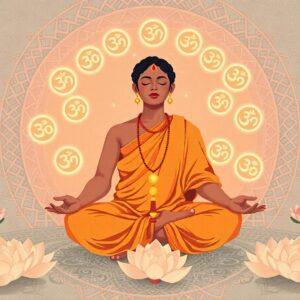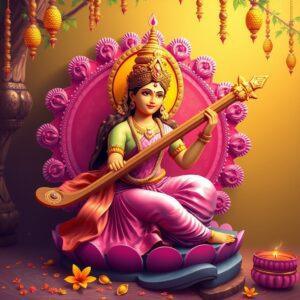
Jainism, an ancient Indian religion, offers profound insights into life after death, guided by the core principles of karma, rebirth, and liberation. This article delves into these concepts, providing a comprehensive understanding of Jain beliefs concerning what happens after death, the pursuit of Nirvana, and the ultimate goal of Moksha. This exploration is particularly relevant for culturally rooted, middle to upper-middle-class Indians aged 25-60, who appreciate tradition and seek authentic ritual items with the convenience of online shopping.
Understanding Karma in Jainism
Karma is a cornerstone of Jain philosophy. It’s the universal law of cause and effect governing the cycle of birth, death, and rebirth. Jainism categorizes karma into eight types, each influencing the soul differently:
- Knowledge-Obscuring Karma (Jnanavarniya Karma): This karma clouds our true nature, hindering spiritual understanding and leading to repeated rebirths. It limits our ability to perceive reality clearly and make wise decisions.
- Perception-Obscuring Karma (Darshanavarniya Karma): This type of karma obscures our perception of truth and reality, similar to a veil over our eyes. It prevents us from seeing the world and ourselves as they truly are.
- Deluding Karma (Mohaniya Karma): Deluding karma fuels our attachments and aversions, trapping us in the cycle of desire and suffering. It creates strong emotional bonds that bind us to the material world.
- Obstructing Karma (Antaraya Karma): This karma hinders our ability to do good and experience positive outcomes. It creates obstacles on our path to spiritual progress, making it difficult to practice virtues.
- Lifespan-Determining Karma (Ayu Karma): This karma determines the length of our life in a particular rebirth. It dictates how long we will remain in a specific form of existence.
- Body-Making Karma (Nama Karma): This karma shapes the type of body we inhabit in each lifetime, whether human, animal, or celestial. It determines our physical form and characteristics.
- Status-Determining Karma (Gotra Karma): This karma influences our social standing, family, and circumstances of birth. It determines the environment and social context we are born into.
- Feeling-Producing Karma (Vedaniya Karma): This karma governs the experiences of pleasure and pain we encounter in life. It dictates the emotional tone of our experiences.
Jain practices, such as non-violence (Ahimsa), truthfulness (Satya), and non-stealing (Asteya), help diminish karmic accumulation. For those seeking to enhance their spiritual practices, Poojn.in offers a wide range of authentic puja items, including incense, diyas, and statues, designed to create a sacred atmosphere for meditation and prayer.
Rebirth and the Cycle of Samsara
In Jainism, Samsara, the cycle of rebirth, is driven by karma and the soul’s attachment to the material world. Souls transmigrate through countless rebirths, taking on various forms, including human, animal, and celestial beings. The concept of Jiva, the individual soul, is central to understanding rebirth. The Jiva is eternal and undergoes transformations based on karmic influences.
Jain scriptures outline four realms of existence:
- Heavenly (Dev Gati): A realm of celestial beings who enjoy pleasure and comfort but are still subject to the cycle of rebirth.
- Hellish (Narak Gati): A realm of suffering and torment where souls experience the consequences of negative karma.
- Human (Manushya Gati): The human realm offers a unique opportunity for spiritual growth and liberation due to the capacity for conscious choice and self-reflection.
- Animal/Plant (Tiryanch Gati): This realm encompasses a wide range of life forms with limited consciousness and agency.
The ultimate objective is to break free from Samsara through the purification of the soul and the attainment of liberation. Ethical conduct, meditation, and adherence to Jain principles are essential for this liberation. This path involves right faith (Samyak Darshan), right knowledge (Samyak Jnana), and right conduct (Samyak Charitra).
Nirvana and Moksha: The Path to Liberation
Nirvana signifies liberation from the cycle of birth and death. Achieving Nirvana necessitates complete freedom from all karmic particles. It’s a state of infinite bliss, knowledge, and perception. Jain texts depict Nirvana as the soul’s return to its pure, unblemished state.
Moksha represents the ultimate liberation from Samsara and all karmic bonds. It is a state of eternal freedom where the soul resides in Siddhashila, a realm of pure consciousness. The path to Moksha involves self-realization and the eradication of all karmic impurities. Jainism advocates a disciplined lifestyle, encompassing vows (Mahavratas) and austerities (Tapas), to achieve Moksha.
For those observing Jain rituals and practices, Poojn.in offers a curated selection of religious items. From handcrafted statues of Tirthankaras to pure cotton puja essentials, our products support your spiritual journey while upholding the principles of Ahimsa and reverence for all life.
Practical Steps Towards Liberation
Jainism outlines specific practices and disciplines to guide individuals on their spiritual path:
- Daily Rituals: Engage in prayer, meditation, and the observance of vows to minimize karmic accumulation. Start your day with Navkar Mantra and dedicate time for self-reflection.
- Dietary Restrictions: Adhere to vegetarianism and avoid root vegetables to minimize harm to living beings. Choose foods that are ethically sourced and prepared with mindfulness.
- Penance and Fasting: Observe fasts, particularly during Paryushana, to purify the body and mind. Engage in acts of self-discipline to strengthen your spiritual resolve.
- Community Involvement: Participate in temple activities and engage in charitable acts to support individual and collective spiritual growth. Connect with fellow practitioners to deepen your understanding and practice.
By embracing these practices, individuals can progress towards Moksha while remaining grounded in tradition and values.
Conclusion
In Jainism, the journey towards liberation is a profound and sacred one. Understanding karma, rebirth, and the pursuit of Nirvana and Moksha are fundamental to this spiritual quest. By adhering to Jain principles, practicing diligently, and leading an ethical life, individuals can purify their souls and advance towards eternal liberation. May this journey inspire and uplift every soul, guiding them towards a life of truth, non-violence, and compassion.


